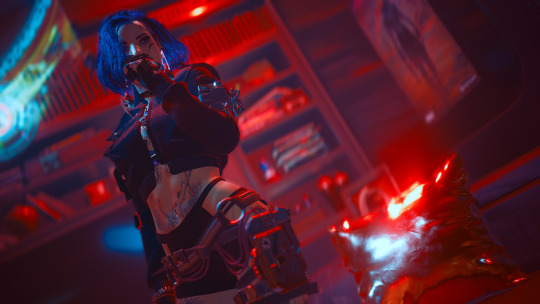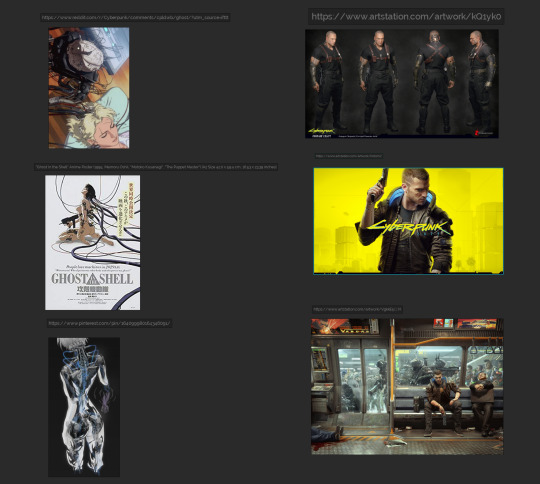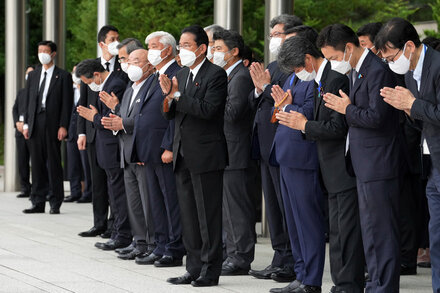#motoko rich
Text






just some of my fav shots from the pre-2.0 (except that one but shhh) because i love my stupid little schrodinger's girl 😔
#johnny silverhand's favorite meatsuit#oc#jaxine motoko bryce#female v#v#cyberpunk 2077#cp77#cdpr#cd projekt red#screenshot#photomode#johnny silverhand#river ward#back to shite quality 'cause that's all this poor lil baby laptop can handle#cause taking nice pics at max graphics means dealing with photomode at 5-10fps and that is impossible without coffee or adderall#one of these days imma be a rich ass graphic designer and buy myself a nasa pc just to take juicy pics of jaxie and johnnie y'all see
12 notes
·
View notes
Text

Ghost in the Shell for the PlayStation 1 console
Reviewing "Ghost in the Shell," particularly the 1995 anime film directed by Mamoru Oshii, from a philosophical standpoint involves exploring its rich narrative and thematic content, which delve into questions of identity, consciousness, and the nature of humanity in an increasingly technological world.
1. The Nature of Identity and Self in a Technologically Advanced World:
At its core, "Ghost in the Shell" grapples with the question of what it means to be human in an era where the boundaries between human and machine are blurred. The protagonist, Major Motoko Kusanagi, a cyborg with a human "ghost" (soul or consciousness) inside a mechanical "shell," embodies this dilemma. The film explores the philosophical question of identity in the digital age – if one's body is artificial and one's memories can be manipulated, what then is the essence of being human? This theme resonates with the ideas of philosophers like Descartes, who pondered the nature of the self and consciousness.
2. Consciousness, Mind, and the Possibility of Artificial Intelligence:
"Ghost in the Shell" delves into the concept of artificial intelligence and the nature of consciousness. The film raises the question of whether a machine can possess a ghost – a consciousness or a soul. This idea invites discussion on the philosophy of mind, particularly the debate between dualism (the mind and body as separate) and physicalism (the mind as a function of the physical brain). The film challenges the viewer to consider the possibility that consciousness might be replicated or emerge in artificial entities.
3. The Ethics of Enhancement and Transhumanism:
The world of "Ghost in the Shell" is one where cybernetic enhancements are commonplace, raising ethical questions about human enhancement and transhumanism. The film prompts viewers to consider the implications of merging human and machine – the potential benefits and the risks involved. It engages with transhumanist philosophy, which advocates for the use of technology to enhance human physical and cognitive abilities and questions what such changes might mean for the human experience.
4. The Concept of Free Will in a Programmed Reality:
The film also touches on the concept of free will, especially in a world where memories and identities can be programmed or altered. The philosophical debate here revolves around the nature of free will and determinism in a technologically advanced society. Are the characters acting of their own free will, or are they following programmed directives? This theme echoes the existential concern about the authenticity of one's choices and actions.
5. The Interplay of Individuality and Connectivity in the Information Age:
"Ghost in the Shell" explores the tension between individuality and the interconnectedness brought about by advanced information technology. The film presents a world where minds can connect directly to networks, raising questions about the individual's place in an interconnected world and the loss of privacy. It invites viewers to ponder the balance between the benefits of hyper-connectivity and the preservation of individual autonomy and privacy.
6. The Impact of Technology on Society and Humanity:
Finally, "Ghost in the Shell" offers a broader critique of the impact of technology on society and humanity. It presents a future where technology has profoundly transformed society, politics, and the human body, prompting philosophical reflection on our current trajectory with technology and the potential consequences for future societies.
In summary, "Ghost in the Shell" is a deeply philosophical film that engages with complex themes such as the nature of identity and consciousness, the ethics of human enhancement, free will in a programmed reality, individuality in an interconnected world, and the societal impact of technology. Its exploration of these themes makes it a rich and thought-provoking work that resonates with a wide range of philosophical discussions.
#Sony#Playstation#PS1#THQ#GhostInTheShell#Ghost in the shell#Kusanagi#motoko kusanagi#Retro#Retrogame#Retro game#Retrogaming#Retro gaming#Pixel Crisis
28 notes
·
View notes
Text
Practice 1:
Assignment 1, Concept Art - Creating "Concepts".
. Blog post 01
Last Wednesday, we attended our first concept art lesson. This class aimed to demonstrate our established abilities in conveying visual concepts through art. Our Professor, Leonardo, permitted us to select three to five inspirational terms and utilize them to execute our first project.
I chose cyberpunk, sci-fi, Chinese martial arts elements, and loneliness.

Cyberpunk
Cyberpunk is distinguished by its striking visual elements, including neon lights illuminating city streets, iconic advertisements lining urban thoroughfares, and towering skyscrapers. The typical color palette associated with cyberpunk aesthetics comprises black, purple, green, blue, and red. These elements collectively contribute to the distinctive ambiance of the genre.
The cyberpunk theme was chosen as I had not previously created any designs relating to this subject matter. I aim to explore new ideas throughout this project.
Bionic human designs are a common motif in cyberpunk works. For example, I have a strong affinity for characters such as Motoko Kusanagi from "Ghost in the Shell" (see images 1, 2, and 3 on the left). Furthermore, in "Cyberpunk 2077", a large number of character designs (see Figures 4, 5, and 6 on the right) feature bionic elements. These designs are characterized by the extensive use of prosthetic enhancements, novel materials, and an intricate network of connecting cables, which together contribute to a distinct and futuristic technological ambiance.

science fiction
There are several different branches of science fiction literature, each representing a unique vision and exploration of the future as it was imagined by people at a particular time in history. For example, the cyberpunk theme is a typical branch of science fiction that reflects the pessimistic visions of the future held by the general public during the 1970s and 1980s, especially when computer technology became popular. Cyberpunk literature usually presents itself as an anti-utopian prediction depicting technological overdevelopment and social degradation, usually accompanied by themes of high levels of urbanization, information control, and the fusion of humans and machines. These works highlight the ethical and social issues that technology can raise, as well as the complex relationship between humans and technology. The emergence of this branch reflected the concerns and explorations of the time about the future direction of technology and society.
Chinese martial arts elements or wuxia elements
Characters in wuxia works often wear traditional Chinese costumes, such as robes, ancient Chinese armor, and hanboks. For example, in the film "Young Detective Dee: Rise of the Sea Dragon" (Figures 1, 2, and 3 on the left), these costumes often reflect the styles of different historical dynasties and regions. Martial arts movements and weaponry weapons combat weapon fighting are important visual features in martial arts works. Wuxia characters use a variety of weapons, such as swords, knives, clubs, darts, and other cold weapons, to demonstrate exquisite martial arts skills. I would like to incorporate elements of Tang Dynasty armor into my work this time, such as the two pictures in the middle.

Loneliness
Loneliness has always been a major spiritual core of the cyberpunk theme, and in the cyberpunk setting people's quality of life has not improved as a result of higher technological levels, but instead has made the rich class richer and the poor class more flatulent and impoverished. Body modification technology and consciousness-uploading technology have made human beings blur the boundaries of individuality.
I'd like to create a female warrior character, a reference to Malenia(As shown in the image below), Blade of Miquella, the goddess from Elden Ring, who guards a city alone and can only be awakened by an intruder.

Reference:
Ghost in the Shell 1 (18 November 1995) Directed by Mamoru Oshii [adult animated neo-noir cyberpunk thriller film ]. Japan United Kingdom:Shochiku (Japan) Metrodome Distribution Manga Entertainment (United Kingdom) .
CD Projekt (10 December 2020) Cyberpunk 2077 [Video game]. CD Projekt Available at: https://store.steampowered.com/app/1091500/_2077/ (Accessed: 30 October 2023).
FromSoftware (February 25, 2022) Elden Ring [Video game]. Bandai Namco Entertainment JP: FromSoftware Available at: https://store.steampowered.com/app/1245620/_/ (Accessed: 30 October 2023).
Detective Dee and the Mystery of the Phantom Flame (29 September 2010) Directed by Tsui Hark [action-adventure gong'an film ]. China
Hong Kong: Emperor Motion Pictures .
2 notes
·
View notes
Text
Bubblegum Black: For A World Without Gold - Chapter 3 & Author's commentary
This is the longest chapter I've written for this fic, despite it being mostly characters talking to one another. 11k words of this shit, man. That's either great or terrible, depending on who you ask. Anyway, here we go!
Doctor Hartland: Relatively obscure character, the guy who provided Roberta with her murder-meds during the Blood Trail / El Baile De Muerte IIRC. He, like many such characters Cyberpunk 2020 would call 'ripperdocs', is what I assume is the front line of medicine in a city like Roanapur. I imagine a city where hospitals are either for syndicate soldiers or extremely rich people, and everyone else can rely on doctors who import or print any medicine they can get their hands on. Presumably 'Traditional Chinese Medicine' is pretty popular, too (did you know that the Chinese government, at least in Hong Kong, prescribed traditional remedies for COVID awhile ago? It did not, of course, help, but it was an alternative to Decadent Western Pig-Dog Medicine I guess. Eugh.)
Revy's Custom Ammo: Delayed-fuse HESH rounds, truly terrible fleshripping monstrosities, are actually something I got from Masamune Shirow's work. You know how in the original manga and in the 1995 movie, Motoko goes "Oh, is that so", shoots up the one guy, and then it takes a second before his cyborg body is blown to bits? That's the effect I'm going for. The tungsten tip is to penetrate body armor and dig into a target's vitals, although that doesn't work 100% of the time with heavier armor.
Still, even if there's no penetration, damage can still be done. HESH rounds were originally designed to kill a tank crew through spalling, hitting the armor with shockwaves such that slivers of metal inside the tank would break off and kill the crew. This is something one can easily mitigate with composite armor and a Kevlar inner lining in the tank, but to translate that back to body armor is probably a little more difficult. One can imagine shockwaves and slivers of armor lining pulverizing human or light Boomer innards even without penetration.
Seburo M-057: A completely fictional Seburo handgun.
For those readers who don't slobber over Shirow's non-porn work the way I do, Seburo is a Japanese gun company built up after around World War Three (in the 1990's in Shirow's timeline). Apparently it might also be a subsidiary company of Poseidon Industrial, the megacorp that becomes the entirety of Japan by the time Appleseed rolls around. Either way, it's a famous Japanese arms company, which makes one wonder: Are handguns legal in Japan in Shirow's world, where they are not in ours? For the sake of lore, let's say that Japan allows organizations like GENOM to possess and manufacture weapons for security purposes, but not individuals. Remember how in BGC2032 there was that whole subplot about how military-grade Boomers in Japan were technically illegal and ideally should only be manufactured offshore? And GENOM just ignored that law for the most part? Well, fuck that game. In the 2060's GENOM happily supplies the JSDF with whatever Boomers they want, the better to defend against China.
Anyway, yeah, the M-057 is a caseless pistol, ammo stored in the gun's handle like normal, but a whole lot more of it, we're talking 18+1 per magazine. In the 2060's, caseless weapons are juuuust starting to make a comeback as a concept, aided by new chemical configurations with higher ignition temperatures and better structural integrity. Revy's handguns are the equivalent of a high-performance electric car compared to everyone else's Toyota Corollas, is probably the best way to think about it.
Second-Highest Boomer Per Capita City: First is Anchorpoint.
Lightning Hawk: A silly Resident Evil reference.
The Master: Okay, this is going to take some explaining. Or at least a picture:

Yeah, okay, you see that gun Priss has? Sure looks like a laser magnum to me, doesn't it? And, hey, look closer, that's definitely its name on the side alongside the name of the sight! So, since no one has never done anything with this information, I have decided to do it my goddamn self.
Now, as I've said before in the Hardsuit Tech document, laser weapons are actually pretty viable so long as you dial down the pulse train to femtoseconds and thereby jack up the pulsed power to the gigawatt or terawatt range. I do not know what the effective overall damage of a tactical-vehicle mounted terawatt laser would be, so in the end I settled on measuring the gun’s stopping power in joules, easy enough to compare to ballistic weapons. For the record, that max power level, 5KJ, is more stopping power than even 7.62 NATO. Which might be overkill even for futuristic high-density capacitors, but what the hell.
Chiborgs: Abbreviation of Chinaborgs.
In this particular iteration of the future, following World War Three between the US and China's respective power blocs (and all the ruination that has brought upon the earth), Cold War 2 has been going on ever since neither side could claim absolute victory due to climate change-induced mass crop failures starving their armies out. So GENOM has one big rival in the 'Sinobloc': The China World Prosperity Corporation, a conglomerate of old State Owned Enterprises that privatized themselves following the war, rolled themselves up into a separate power structure, about as independent from the CCP as one can get, and resumed Chinese imperial efforts in the old Belt and Road bloc.
But - but but but - they've never quite managed to emulate the entirety of Boomer technology. Oh sure, they've got robots, but Boomers are biomimicry nanotech down to the cellular level, a common platform for alternative life. WPC doesn't have that, so they've aligned with the turbo-Leninists in the Party, arguing that GENOM's Boomers alienate the proletariat from their labor on a societally toxic scale, and simply continued the use of prosthetics and augmentations coupled with inferior robotics to an absurd degree.
A Chiborg, then, is a WPC-produced set of augmentations designed for relatively specialized labor, turning a human into a near-machine relying on constant maintenance and subject to constant surveillance. It’s not like these ‘shells’ are expensive, or cheap but low-quality. The WPC is more than happy to sell, as per Party directives, at an ever-so-slight-loss even in economically turbulent times. The insidious part, besides the addiction to maintenance and the monitoring of every micro-movement the brain orders the body to make, is who ends up with these things permanently grafted into themselves. Migrant workers in the bottom tier of the hukou system; ethnic minorities treated as culturally and mentally inferior to the Han majority; Taiwanese or Koreans or North Viet treated as near-slaves, the ‘curse’ of their WW3-era resistance against the benevolence of True Socialist Xi Jinping Thought with Chinese Characteristics For The Eternal Bright Future having marked entire families with generations of debt only payable by concentration camp labor. Voluntary, of course, but, y’know, not really.
Mycoplastic Packaging: Fungus-derived materials that have replaced most petrochemical-based plastics by 2060. In the case of easily-biodegradable packaging like what the Master comes in, it's more akin to a sort of micromesh made from hymenophore tubes.
Check out this Vice article about more high-performance materials that fungi could help make. It's not really the same principle, but I imagine it's... plausible, to grow the right materials with some funky bioengineering.
Singto Phumici: Proud Lion in Thai. Note how some districts have English names and others have Thai. You could, I imagine, track the economic bracket of a given district, or perhaps who it relies on for authority, by the language used in a name. Might throw a Cantonese name or two in there later. We'll see.
Sawyer's Bloody Business: Yes, most of the meat in the 2060's is lab-cultured tissue or an imitation thereof, 3D printed into a meal. And yes, Sawyer feeds human corpses to flesh-eating bacteria which are supposed to build up a nice big blob of biomass that can then be fed to meat cultures. One meat becomes another, just with more extra steps and less maintenance than feeding human remains to pigs as one might do in the old days.
You know, they've managed to print lab-grown Wagyu. How much longer before Mickey-D's is marketing luxury synthmeats in its products? I wonder.
Sawyer In General: The idea of Sawyer being an obsessive Priss fangirl has been a fairly crucial part of this crossover ever since I started thinking about it in early April. Perhaps it runs against her canon characterization as a stone-cold killer in Gore Gore Girl, but all we have to go off of for G3 so far is chapter summaries on the wiki, and it strikes me as a somewhat sillier spinoff than mainline Lagoon. Which is fine, but then what the hell, I have license to fuck around with what we're given in terms of Sawyer, because It Is Fanfiction. I guess I find her at once intimidating but kind of pathetic? I mean, those scars on her arms definitely aren't something someone else did to her, if Hiroe's claim that she was based of a friend with depression is to be believed.
Without spoiling anything, suffice to say that in earlier drafts of this chapter Sawyer was even more of a mentally unwell gore fiend than she is here. My beta took issue with it, said that there was no way that what I want to do with the character in the long run made sense if she was like that. And you know what, he was right.
We haven't seen the last of the Gore Gore Girl, not by a long shot. I didn't write that scene to set a big ol' nothingburger up. You'll see.
Priss vs. Revy: Okay, could Priss actually beat Revy in a shootout, even by one point or whatever? Hard to say. Priss's skill as a marksman is more up in the air just because we've seen less of her overall, and less emphasis is placed on her ability to shoot well. But I think that she's got some skill, at least, from her time as a bosozoku and from having to make crucial railgun shots as a Saber.
Also... she kind of cheated. A little. Not a lot, but enough to win. Those who have read Anatomy of a Lovedoll, or remember a little side bit from Chapter 2, will recognize how.
Fediverse: Mastodon is the most famous of these platforms, but the fediverse is more than just 'the open-source Twitter replacement', it's more... federated networks are disconnected communications networks that can still talk to each other over a common platform, so the idea behind the fediverse is a galaxy of 'instances', small servers run by a person or organization that can all share common accounts with differing rules of operation and moderators and stuff. No one company owns the protocols used, and so it's a lot more of a wild west - plenty of people who were kicked off Twitter for good reason (Nazis) have taken root on fedi instances - but the idea in mentioning fediverse-like platforms in the noosphere of the future is that they're sort of the alt-internet, the cyberpunk-y version of the internet that has otherwise been carved up by big platforms and those Everything Apps I was talking about in the Chapter 2 notes (even more prescient now that Twitter-cum-X is being set up by Elon to be Explicitly That). Forums that run the gamut from respectable to shady; software and 3D printing libraries of varying quality and trustworthiness; piracy and crime and all the corrosive forces that eat away at the respectable foundations of the Noose - these are the kind of networks Benny and Jane love to hang out on.
In other words, the only ways to use the internet of the future are Facebook, Amazon, and 4chan. God, don't you miss the days of nonplatformed webpages? Let's bring Geocities back, guys. Let's do that to save the internet.
Tewwowizm: Are the Knight Sabers terrorists? In the eyes of many, they probably are, a menace against the prosperous GENOM-lead global order that... you get the idea. The hope is that enough people can recognize that the Sabers mostly kill GENOM execs and blow up GENOM assets like industrial facilities and Boomers, and avoid killing innocents for the most part. To make them superheroes and not supervillains in the eyes of the body public.
This was something I wanted to play around with in this conversation as it organically unfolded. At least, I think I did. This conversation textually pulling double-duty as a way to lead Eda off the trail of the Sabers working with the Lagoon Company and also letting Dutch get all weird and philosophical... I'm happy with it, but it's weird all the same. Either way, it does get to the desired outcome, highlighting how easy it is to needle Rock now after... well, have you Lagoon manga readers figured out who died yet? Yeah, I bet you have.
Eda's Pet Naming: Not in the manga, but I think it's funny and kind of mean-spirited on Eda's part, so in it goes. Okay, what else to put in here...
What I'm Stealing From: You may have noticed, dear reader, that I'm writing a lot of Rock. Hell, the next chapter is mostly his perspective again. This is probably not a good thing, because even if I find him super interesting as a character, most people are probably here for the girls, not him. Too much Rock, too much of the Lagoon cast in general and the Sabers risk being only bit players in a larger drama, which they should not be. So that's a balancing act I haven't quite gotten the hang of.
Anyway, there's one Lagoon fic I want to bring up real quickly that has had a major impact on how I think about the franchise.
It's called Apotheosis, which is, in my opinion, perfect in every conceivable way. While it lacks the balls-to-the-wall super-action of Lagoon as we know it, it makes up for that by having really interesting prose, heartfelt character development, firm grounding in late 90's history, and really getting inside Rock's head, both his best impulses and his worst ones. It almost made me cry at the end, and the only reason I haven't reread it extensively is because I'm afraid I'll either succumb to Fic Envy and start kicking myself, or I'll just rip off chunks of characterization and plot wholesale. Which is kind of what I'm doing now to navigate the Lagoon cast as people, but to a lesser degree. The Sabers have to provide a catalyst, a reactant, stuff like that - that means the plot can't be the same thing beat-for-beat. It better not be.
Are there other fics that have made me think about this franchise deeply? Yep. Sure are. But I don't think any are going to be as radically influential on this fic as Apotheosis. We'll see. I have high hopes for this project.
Anyway, rough draft of Chapter 4 is already done, it just has to get edited but it's pretty short. Next time, a deal will be made that will change the way you think about Roanapur forever...
3 notes
·
View notes
Text
A Yale Professor Suggested Mass Suicide for Old People in Japan. What Did He Mean? (Motoko Rich and Hikari Hida / NYTimes). An appalling proposal. Everybody counts or nobody counts.
1 note
·
View note
Text
Antonio Velardo shares: Woman Rescued From Rubble in Japan Five Days After Deadly Quake by Motoko Rich and Miharu Nishiyama
By Motoko Rich and Miharu Nishiyama
The survivor, who was in her 90s, was dug out from under a collapsed house, injured but responsive.
Published: January 7, 2024 at 12:07AM
from NYT World https://ift.tt/Ti7WuR6
via IFTTT

View On WordPress
0 notes
Text
What is Literacy in this new age of technology and emerging media?
What is Literacy in this new age of technology and emerging media? Does literacy count only in the form of ink and paper or has it become so much more? According to a New York Times Article by Motoko Rich titled Literacy Debate: Online, R U Really Reading? “On paper, text has a predetermined beginning, middle and end, where readers focus for a sustained period on one author’s vision. On the…
View On WordPress
0 notes
Photo

"In Rare Move, Japanese Pop Star Comes Out Publicly as Gay" by Motoko Rich and Hikari Hida via NYT World https://www.nytimes.com/2023/07/26/world/asia/japan-gay-j-pop-shinjiro-atae.html?partner=IFTTT
0 notes
Text
36 hours in Tokyo | Lifestyle News,The Indian Express
Written by Motoko Rich
For 2 1/2 years, pandemic border controls kept international travelers out of Tokyo, leaving its neon shopping precincts and most popular temples and shrines to the locals. Now, with foreign tourists welcomed back since October, those willing to explore beyond highly trafficked neighborhoods like Harajuku, Shibuya and Shinjuku and wander down side streets in places like…

View On WordPress
0 notes
Text
Japan’s Leader Tries to Honor Abe’s Legacy, While Building His Own

By BY MOTOKO RICH AND HIKARI HIDA
Prime Minister Fumio Kishida says he will pursue Shinzo Abe’s goals, such as a stronger military. But he has also set himself apart from his slain predecessor.
Published: July 18, 2022 at 05:00AM
from NYT World https://ift.tt/xcyVYHw
via IFTTT
0 notes
Link
By Eimi Yamamitsu, Motoko Rich and Makiko Inoue
KYOTO, Japan — He can’t get the women out of his mind.
A day after an apparent arson killed 33 people at an animation studio in the Japanese city of Kyoto.
Much was still unknown about the Thursday fire, which appeared to be Japan’s worst mass killing in decades. The police identified Shinji Aoba, 41, as a suspect in the case, based on statements they said he made when he was apprehended. They said Mr. Aoba was being treated for severe burns and had not been arrested.
Japanese news reports, citing unnamed police sources, said the suspect had told the police that he started the fire because he believed the studio, Kyoto Animation, “stole a novel” from him.
NHK, the public broadcaster, reported that Mr. Aoba had served time in prison for robbery and that he was being treated for an unspecified mental illness. The report, which cited an unidentified source, said he lived in the city of Saitama, near Tokyo.
As of Friday, none of the names of the 33 people killed in the fire had been released. What was known was that almost two-thirds of them — 20 — were women.
That appears to reflect a trend in Japan’s animation industry, as well as the hiring practices at Kyoto Animation. There are about twice as many women as men among working animators in their 20s, according to Daisuke Okeda, a lawyer and adviser to the Japan Animation Creators Association.
Male animators still lead the industry, and they outnumber women among animators over 35, Mr. Okeda said. But Kyoto Animation — known as KyoAni to its fans — is known for employing more women, particularly younger women.
More than half of the workers in the burned building were women, based on figures released by the Kyoto fire officials about the dead as well as the dozens of injured.
On Friday, a man distraught about his 21-year-old granddaughter, who worked at Kyoto Animation, told NHK that he could not find her name on lists of people taken to local hospitals.
“She was my pride,” the man, Kazuo Okada, 69, said of his granddaughter, Megumu Ohno. “Her name started appearing on the screens of anime movies. I was so happy to see that. I was proud of her. I want to see her face soon.”
Kyoto Animation was co-founded by Yoko Hatta and her husband, Hideaki Hatta, in 1981, and went on to produce high-quality, meticulously detailed works. They included “The Melancholy of Haruhi Suzumiya,” a science fiction series based at a high school, and “Lucky Star,” whose intelligent female protagonist is distracted from her studies by anime and video games.
Kyoto Animation also played a role in the careers of two star women directors of television anime, said Patrick W. Galbraith, a lecturer at Senshu University who has written extensively about the art form. “That’s significant,” he said.
Naoko Yamada directed the series “K-On!” for Kyoto Animation, and Hiroko Utsumi directed “Free!” a series about a boys’ swimming team. “Free!” stood out in the anime world, often known for being preoccupied with the female form, because it focused on the male body instead.
Ms. Utsumi has since moved to another anime studio, Mappa. According to Nikkan Sports, a daily newspaper, Ms. Yamada was not hurt in the fire.
Kyoto Animation is also unusual among anime studios in that it pays its workers salaries, rather than freelance fees. Japan’s animation industry has been accused of exploiting workers, who work long hours for low wages.
Ironically, KyoAni’s system may have exposed its workers to greater risk by concentrating so many of them in one studio. “It’s a rare system in the industry,” Mr. Okeda said.
#animated films#tw murder#tw arson#tw death#animation studio#kyoto#tw mass murder#tw massacre#anime#animation#makiko inoue#eimi yamamitsu#motoko rich#ny times#new york times#nyt
20 notes
·
View notes
Link

By BY PAUL MOZUR, ELSIE CHEN, YAN ZHUANG, BEN DOOLEY, MOTOKO RICH, AMY CHANG CHIEN, AMY QIN AND JASON GUTIERREZ from World in the New York Times-https://ift.tt/3hu5wIG
Celebrations in China are limited by the pandemic, except in Wuhan. New York Times
0 notes
Photo

Commission Panel Art of Motoko Kusanagi from Ghost in the Shell!
16 notes
·
View notes
Text
Bucking a Global Trend, Japan Seeks More Immigrants. Ambivalently.
KASHIWA, Japan — Vexed by labor shortages in their rapidly aging country, lawmakers relaxed Japan’s longstanding insularity early Saturday by authorizing a sharp increase in the number of foreign workers.
Under a bill approved by Parliament’s upper house in the early-morning hours, more than a quarter-million visas of five-year duration will be granted to unskilled guest laborers for the first time, starting in 2019.
[Motoko Rich] www.nytimes.com
0 notes
Text
Antonio Velardo shares: Calma y orden en un avión de Japan Airlines envuelto en llamas by Motoko Rich and Hisako Ueno
By Motoko Rich and Hisako Ueno
Los 367 pasajeros y los miembros de la tripulación evacuaron a salvo gracias a un personal de vuelo bien entrenado, una aeronave avanzada y, en gran medida, una relativa ausencia de pánico.
Published: January 3, 2024 at 05:33PM
from NYT En español https://ift.tt/Iit0Syc
via IFTTT

View On WordPress
0 notes
Text
What is Literacy in this new age of technology and emerging media?
What is Literacy in this new age of technology and emerging media? Does literacy count only in the form of ink and paper or has it become so much more? According to a New York Times Article by Motoko Rich titled Literacy Debate: Online, R U Really Reading? “On paper, text has a predetermined beginning, middle and end, where readers focus for a sustained period on one author’s vision. On the…
View On WordPress
0 notes